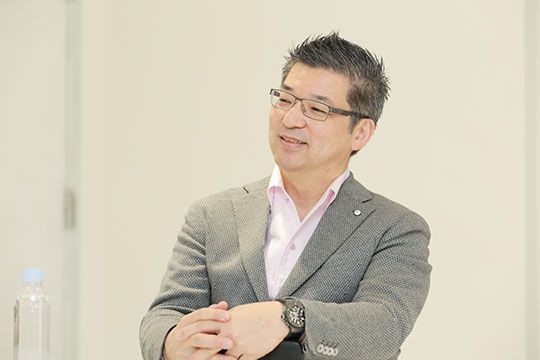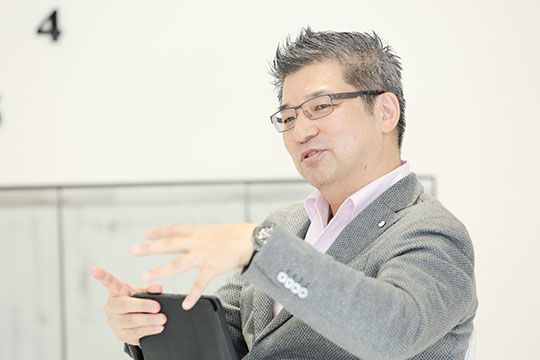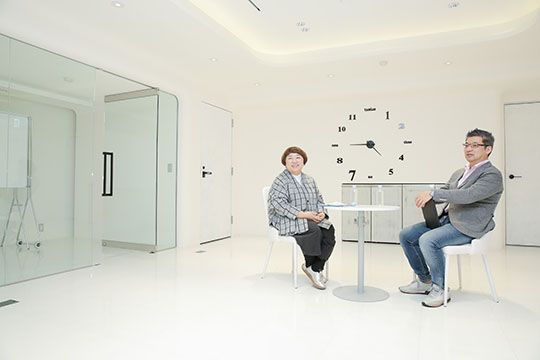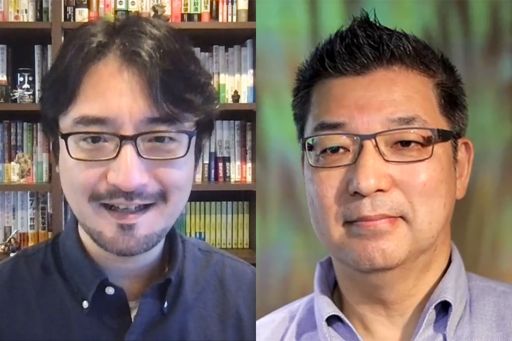Teleworking has become widespread due to the COVID-19 pandemic and communication in the workplace has changed considerably compared to the past. This trend will undoubtedly accelerate going forward. One direction of the trend that is attracting attention is the "metaverse," in which people interact by constructing a digital three-dimensional virtual space.
In such a situation, how will human beings weave relationships with each other going forward?
In this article, we will introduce the discussions conducted between Natsuko Yamada of Shigoto Soken Inc., who continues to practice team building in the essential sense by using graphic facilitation, and Masayuki Chatani of KPMG Ignition Tokyo. During these discussions, they envision and fantasize how to weave workplace relationships in the post-COVID-19 era and how communication and technology should be used 50 and 100 years from now.
Contents
- What Is Graphic Facilitation?
- Environment where People's Performance and Growth are Fulfilled
- What Emerges from Graphic Facilitation
- “Something" that Cannot Be Expressed with Words Is Conveyed
- There Is a Risk of Opening Pandora's Box
- Difference between Organizations Where People Can Express Their Opinions and Those Where They Cannot Do So
- Profile of Interviewee
What Is Graphic Facilitation?

(Natsuko Yamada, CEO of Shigoto Soken, Inc. (left), Masayuki Chatani, Representative Director & CEO of KPMG Ignition Tokyo and CDO of KPMG Japan (right)) *Professional affiliation and official position in the article are at the time of publication.
Chatani: I imagine that the topic “business thinking design thinking artistic thinking” is of great interest to anyone involved in business. Especially today, there’s a lot of talk about the importance of "artistic thinking," which expresses various things with nonverbal elements.
I think that this is an important way of thinking when considering the future of companies and this is when I think of "graphic facilitation," which is at the core of your activities.
As it is a very interesting approach, I wanted many people to know about it and so I set up this dialogue with you. First of all, can you explain graphic facilitation to us?
Yamada: Thank you. When I explain "graphic facilitation," I often refer to "graphic recording" as something similar to it.
Graphic recording can be explained as summarizing what is being said and neatly compiling it for the record with the outcome being the picture that is drawn.
Graphic facilitation, on the other hand, is an effort to "facilitate" using graphics because language has its limits. The outcome is measured in terms of "whether the participants of the meeting were facilitated or not."
I originally started the team-building business at “Shigoto Soken” to "deepen relationships" between people gathered together in various organizations. It was based on the idea that “people cannot understand each other deeply or weave relationships just by sharing what they can see or through language. It’s important to share feelings and atmosphere as well, and we are able to build a relationship of trust while doing so.”
Though there are cases where people are afraid of confrontation or conflict that may occur when deepening relationships, each person is different and so it’s natural that there are differences and that there will be confrontation and conflict due to differences. Confrontation and conflict themselves are not bad but trying to hide them makes the relationship worse.
For instance, "to put a lid on something that is difficult to say to the other person without saying it" or "to avoid talking about something that should be confided" can have a negative impact on relationships.
This means that when you try to move forward by pretending not to see the discomfort that has not yet been expressed in words but somehow exists, this behavior of "pretending not to see" and the conflict that exists there are leaked and conveyed to people around you in a subtle manner and lead to further misunderstandings and conflicts.
“Graphic facilitation" uses pictures and colors to draw and visualize "something" that has not yet been put into words, elements that even the participants are unaware of, the atmosphere behind the words, and tacit knowledge and values that are too obvious for people to verbalize.
I feel that unless we visualize, pause and coordinate our perceptions, we modern people tend to push forward by neglecting that "something" and rush to produce results and accomplishments.
A picture is drawn to get people to look at what we want to inherently value as human beings and what we need to share with each other and align our perceptions of. The participants will then have a thorough dialogue while looking at the drawing, understand what is being talked about as their own affair, and think and act on their own initiative. This is what "graphic facilitation” is.
Environment where People's Performance and Growth are Fulfilled
Chatani: I felt that what you are doing is communicating the importance of reminding people to improve their relationships. When did you first feel that this is important?
Yamada: I used to be a teacher at a school that trained creatives. There were many children at the school who were good at drawing, had a good sense of color, and so forth. While the importance of their abilities as individuals was of course crucial, I realized that relationships with class members had a greater impact on their growth and performance as a person than their individual abilities.
In other words, whether each student is aware that he or she has a "place" in the class is a very important factor in the learning environment.


A good relationship does not mean getting along superficially, but rather being able to say things that are difficult to say to each other. It can be said that the existence of such a relationship leads to stimulating each other and mutual growth. I strongly felt that schools must create such an environment. Otherwise, individual abilities will only be developed "within the scope of what is visible" and we will not be able to build relationships with others or grow as a person.
Chatani: Does this mean that the approach of graphic facilitation was born out of this realization?
Yamada: In fact, it took me about 15 years to get there, which includes my experience as a teacher.
First of all, when I was a teacher, there were students who graduated and got a job but quit their jobs within three years and came back to consult me, saying, "I quit my job. Do you have a job offer for me?" When I asked, “Why did you quit?," most cited relationships as their reasons. I felt that in an overwhelming number of cases, they could have continued if only they had been able to manage relationships.
That’s why I realized that people cannot grow by being only involved in relationships within the school. In other words, people cannot work vigorously unless they can properly develop good relationships within the company that accepts them after graduation.
I believe that the relationship between people is like "water quality.” For a goldfish in a bowl to swim well, it’s very important that the water is clear. If this is the case, the quality of the water at the place where people work must also be very important. I therefore decided to quit my job as a teacher and start the current company, "Shigoto Soken".
I studied counseling and team coaching for weaving relationships, and tried everything I could think of including workshops incorporating experiential learning. However, it’s extremely important to change the way meetings are held and communication is conducted in the workplace on a daily basis, rather than doing something special such as going out of your way to hold a training camp. Unless we address the situation at the scene, training and workshops will end as just one-time efforts.
The idea of "communication using clay” came up when I was thinking about what I could do about this. As I had studied sculpture, I thought that we could explore the non-verbal aspects by using oil clay.
However, even though I packed a large amount of oil clay in my suitcase and visited my client company, the participants did not really want to touch the clay or take it home with them....
So, I gave up trying to express things in three dimensions and switched to exploring the nonverbal aspects with a two-dimensional approach of drawing on whiteboards and walls. It was somewhat of a compromise for me (laughs).
What Emerges from Graphic Facilitation

Chatani: It’s very interesting to hear that there was an "oil clay approach" before the graphic facilitation approach. So, was the graphic facilitation approach established as soon as you "compromised" with the two-dimension approach?
Yamada: Well, It was created gradually as I was called by companies to do ordinary facilitation as “Shigoto Soken.”
When I was invited to corporate meetings as a facilitator from the outside, the participants seemed to think, "As a professional facilitator is here, she will ask clever questions” and they often began to “take a break” rather than actively participating in the meeting.
The facilitator asks questions to get people to talk but the more I did so, the more it became a "one-on-one" relationship between the facilitator and one of the participants, and I was unable to create a situation where employees talked to each other.
The facilitator can work with the organizer in advance to determine the best way to structure the meeting and guide the participants closer to the "answer" within the time frame. However, is this really good for the people who gathered in the meeting? I didn't think so. Would they be able to go back to work and move forward with what they had decided as their own? Would they be able to take it seriously? I doubted it.
So one day, I said to them, " I will not intervene today. I will not ask questions. Last time, you talked about aiming for Mt. Everest instead of Mt. Fuji. Today, let's start by continuing from there" while I drew a picture.
There was some confusion at first but gradually, everyone began to talk.... As I drew a picture of the conversation, the structure of "what one talked about becoming a picture, and continuing to talk about it while looking at the picture" was established naturally. Then, they were able to direct their attention to what was being talked about and focus on it.
Of course, there are times when a hushed silence takes over and the discussion does not proceed, but I draw a picture of the hushed silence as well. Then, one of the participants suddenly starts saying, "Actually, I don't know why I’m here.” When I draw a picture of the “atmosphere and situation of the participant who is talking about something different from the main topic,” some of them begin to realize their true feelings, which they were not fully aware of, such as, “Ah, maybe I wasn’t talking about the issue but was thinking about my own self-preservation.”
Having the participants become aware of the state of the “scene” in this way was the first thing I did with graphic facilitation. We did not have a name for it at the time but as it was an approach of "facilitation using graphics," we named it as it was.
“Something" that Cannot Be Expressed with Words Is Conveyed
Chatani: How many companies have conducted sessions incorporating graphic facilitation so far?
Yamada: I counted over 970 companies when I published the book "The Graphic Facilitation Textbook" in 2021. Some are large companies and some are non-profit organizations and small companies. I have gone inside companies that were arguing about business succession and I drew pictures of the different positions and views of the predecessor and successor as well as employees who had been involved for a long time.
Chatani: What kinds of things are discussed in business succession situations?
Yamada: We receive many requests from those who are on the inheriting side, and they strongly feel that they need to understand more about invisible values, such as "how does the predecessor want the company to grow in the future," rather than about tangible things like products.

On the other hand, as there are many cases where it is necessary to change the form of the business in line with the current times, graphic facilitation is often used to unravel what must not be lost in taking over the name of the company even if the business has to be changed.
Chatani: I guess it’s difficult to unravel the feeling part.
Yamada: If it’s important to stay close to the thoughts and feelings of the person speaking, I think it’s a bit coarse to summarize it only at a verbal level. I think that it’s more important to listen closely to what the person is trying to say and what is important to them such as “the thoughts they want to leave” to their successors after they pass away.
Chatani: Will they actually be conveyed?
Yamada: Well, I once did a graphic facilitation for a company whose founder was 90 years old and retiring from the chairman's position. Employees were moved to tears listening to him talk about his war experience, the recovery from the war and the history of the company, and I thought, "Ah, even though the times are different, we can share the same feelings.” I also learned that it’s possible to relive those times.
There Is a Risk of Opening Pandora's Box

Chatani: Graphic facilitation is a very interesting approach to depict the non-verbal aspects of a scene, but are there any cases that you will never forget?
Yamada: Each time is different, and they are all impressive, but there is always a moment when the "Pandora's Box opens." This means that it exposes something that people have been trying not to look at or kept a lid on.
While there are many benefits to team building by sharing real feelings with each other, real feelings are not just kind, and revealing them can be both exciting and risky.
For example, there was a meeting at a company where many managers gathered to talk about future working style reform and diversity but the president could not stand the many honest opinions that came out and finally became angry.
As president, he wanted to get everything that the current managers were thinking out of their mouths and spin it from there, but he did not anticipate the shock he was going to get from their true feelings coming out of the Pandora's box.
For companies that have a top-down tendency, especially companies that want to permeate what those at the top say, it would be extremely risky to try to reveal what is in each person's gut in a bottom-up approach.
Chatani: This means that you have opened nearly 1,000 such boxes.
Yamada: That’s right. However, when a company asks for an outside facilitator, I think the people in the company know that there is "something" that cannot be opened by their own people.
Difference between Organizations Where People Can Express Their Opinions and Those Where They Cannot Do So
Chatani: I believe that each company has its own culture. For instance, in a company with an "open and opinionated culture," opinions are likely to come up actively in discussions. Of course, there are many companies that don’t have such a culture. What do you think is the difference between the two?
Yamada: I’ve been involved in various companies as an outsider, and there’s not much difference in “whether opinions come out easily or not.” Even if the company is the latter, I feel that "even though opinions are not expressed in words, they sneak out into the air.”
For example, there are times when the participants’ expressions show an unconvinced dull reaction after the most senior person in the room expresses a reasonable opinion. I try to use graphic facilitation to depict the atmosphere of "not being so convinced" so that the participants can share it with each other.

Chatani: If that atmosphere becomes visible, it certainly could lead to tantrums, like the president just mentioned, or even rebellion and friction among coworkers. I imagine that some may get into a really nasty mood.
Yamada: It’s a harrowing experience every time, and many people get emotional during the course of the initiative. However, I believe that a true relationship cannot be created without stepping in and revealing things to that point.
Now that teleworking and online meetings have become common due to the COVID-19 pandemic, I believe that the "stepping in" approach, which I just mentioned, is likely to be weakened in such an environment. It’s likely to lead to “I want to convey this, but I feel that it’s not conveyed well, but I guess it’s OK.” Also, as you can return to your personal daily life once you close the computer, it may be easier to separate work and personal life.
I feel that we need to learn new ways of communicating with each other so that we can step in and talk openly with each other even in such an online environment.
Profile of Interviewee


Natsuko Yamada
CEO of Shigoto Soken, Inc.
Representative Director of the Graphic Facilitation Association
Natsuko Yamada is an Organizational Development Facilitator/Creative Facilitator/System Coach. After graduating from the College of Art and Design, Musashino Art University, Natsuko Yamada joined Vantan Inc., which operates training schools for creators, where she served as the school director and a director of various schools. Subsequently, she was involved in training employees and instructors and reforming the personnel system as the training supervisor of the Personnel Department. She established the Human Resources Business Department in the company and was engaged in activities inside and outside the company as a career counsellor and a skill improvement trainer. Through her experience in the field of education, she realized that relationships between people have a major impact on the ability of individuals to perform and became independent thereafter.
In 2008, she established Shigoto Soken, Inc., which is involved in organizational development, vision creation and leadership businesses utilizing graphic facilitation and System Coaching®. The company is engaged in team building and educational activities at various worksites, ranging from small organizations to major companies as well as local communities. It has been involved with over 950 organizations so far. The company also provides training courses for graphic facilitators, in which 2,000 students have participated. There are many participants who shed tears at the facilitation that is carried out with lots of love.
She appeared regularly in NHK General channel’s "Weekly News Deep Reading" as a graphic facilitator for a year from 2017 to March 2018. She also attracted attention when she participated in NHK General’s “Thinking Will Change the World, ‘Everyone is Pascal!’” as a graphic facilitator in May 2021. She has translated and supervised books including “Generative Scribing; A Social Art of the 21st Century” by Kelvy Bird (Eiji Press). Also, she published a book "Graphic Facilitation Textbook" in July 2021(Kanki Publishing).
Follow us on KPMG Ignition Tokyo LinkedIn for the latest news.
Connect with us
- Find office locations kpmg.findOfficeLocations
- kpmg.emailUs
- Social media @ KPMG kpmg.socialMedia




